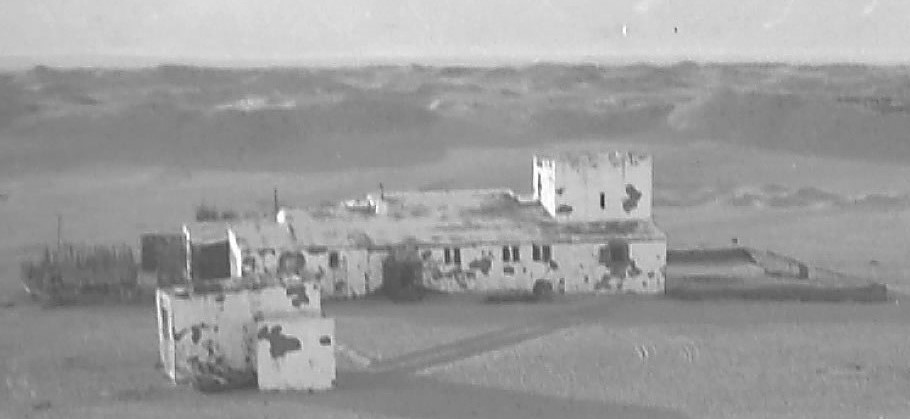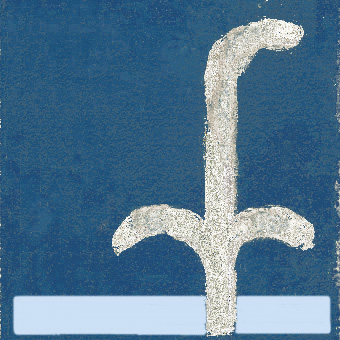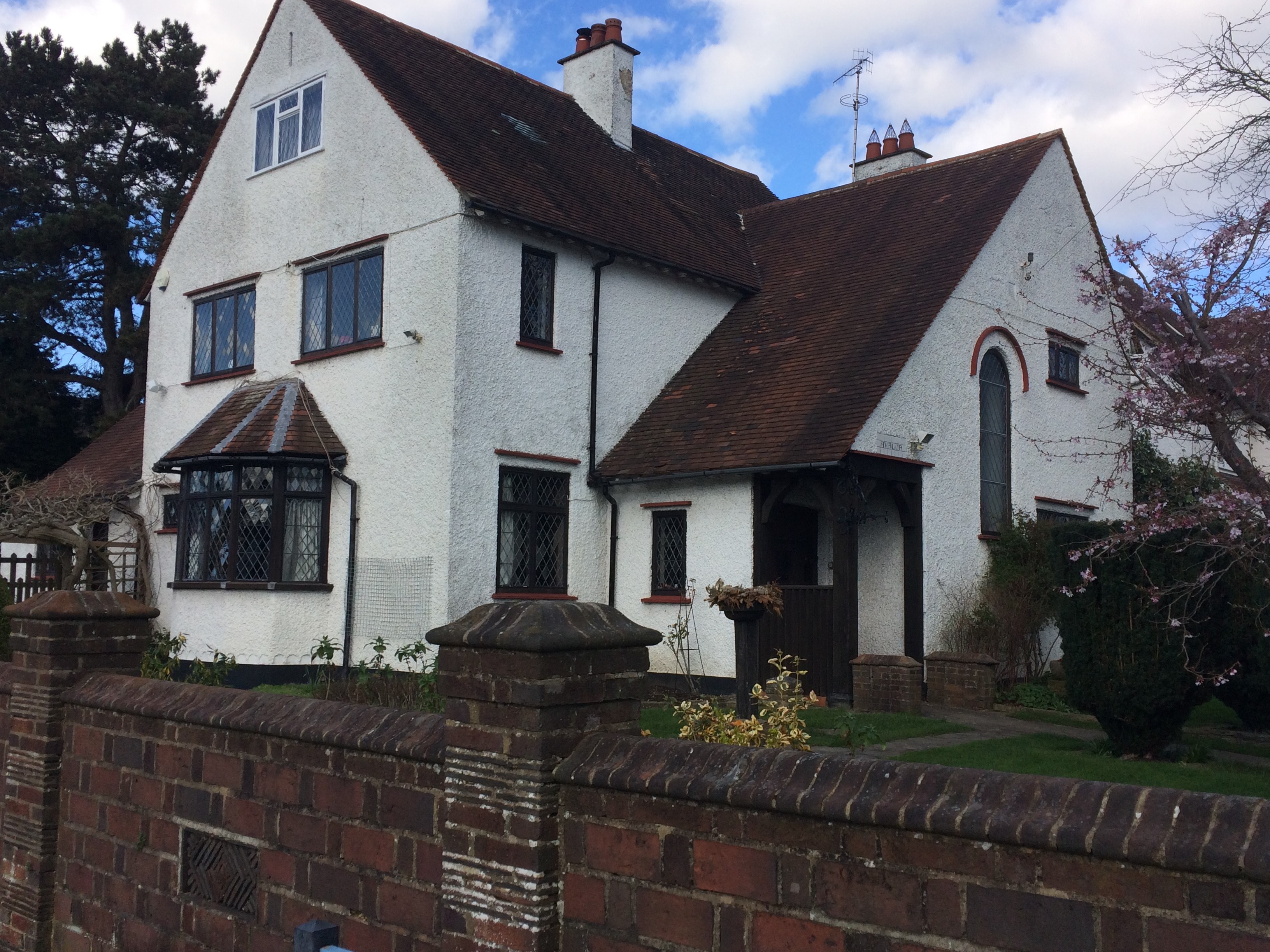
Improving and extending the Abydos dig house
Author: Susan Biddle.
Those who have spent time and effort on DIY home improvements or repairs may enjoy comparing their experiences with the work done by Myrtle Broome and Amice Calverley on the Abydos dig house at Arabah el-Madfunah, Baliana 1929–1937.
Amice and Myrtle made improvements to the camp facilities each year. Myrtle and her father had designed and decorated many of the interior features of their Arts and Crafts home, “Avalon”, and she proved ingenious in designing fittings and furniture for the dig house.
Wood was in short supply, and most of the fixtures and fittings were made from odd bits of left-over planks or packing cases. On arrival in December 1930, they “made a really splendid book case out of a packing case, it is all neatly lined with brown paper and is really a handsome piece of furniture”, and Myrtle also fixed herself a hanging wardrobe in her bedroom. In 1933 she made a towel rail with palm sticks:

Letter 303, p. 4
She was still making improvements in the last season, when she fixed a shelf over her washstand, with an enamel plate for sponges, a hook for her facecloth and room for her nailbrush, etc.
In 1931 the carpenter was instructed to use packing cases to make double doors for the garage and produced “two excellent doors, most wonderfully patched together”. Myrtle conceded that“of course they do not hang straight on their hinges, nor do they meet all the way up in the centre, but no one troubles about little things like that out here”. She doubted whether a British carpenter would have been so ingenious.
The reuse of packing cases could sometimes result in some odd decorative effects – in 1932 the carpenter, “a marvel at neat patch wood”, made them two more doors from packing cases. These amused their visitors as “one gets, ‘Keep away from the boilers’, & ‘glass with care’ & sundry odd bits of inscriptions all over them — some upside down”. In 1934 the carpenter, together with Myrtle and Amice, made some more corner cupboards, again with “each shelf … made up of from 6 to 10 bits. This sort of thing”:

Letter 303, p. 2
The carpenter sawed the bits as marked by Amice and Myrtle, who then nailed them in place “after having straightened the nails!!”. Nails were a recurrent issue – investigating in 1933 why a table was so unsteady, Myrtle found the nails had been driven in at all angles so the wood was splitting. She commissioned the local blacksmith to make iron brackets which Sardic, the head servant and man of many talents, then fixed to the legs and top to strengthen it:
Nails could cause bigger problems too. In 1931 they had a mud-brick road made to the garage, as the car was repeatedly suffering flat tires from the large number of nails in the area. Myrtle surmised that these nails were the result of ten years’ worth of opening Egypt Exploration Society packing cases. For this road they reused the bricks from the ruins of some of the houses used by Flinders Petrie’s workmen during the 1899–1903 seasons (seasons described by Flinders and Hilda Petrie in Petrie’s Journals for 1899–1900, 1900–1901, 1901–1902 and 1902–1903). Myrtle commented that “it seems strange that mud bricks, made by the ancient Egyptians for their tombs, should be used for a motor road, the bricks are many of them quite perfect & even have the imprint of the fingers that made them” – not perhaps a re-use likely to be approved today.
In later years, as the team expanded, more extensive works were required. In 1934 they added an extra three rooms to the house. This was “a very simple matter, you make lines on the sand the size you want the rooms to be, & the men begin to put up the walls with mud bricks using a mortar of sand & mud. Then you tell the carpenter how many windows & doors you want, & he makes them. & you show the builder where they are to go. & he fits them in, & then the roof goes on. & you whitewash it. & leave it a little while to dry & your house is ready”. In accordance with the English tradition of the owner standing the workers drinks when the chimneys went onto a house, Amice stood the men a feast including a goat when the roof of this annexe was completed.
Initially their bread was baked by Sardic’s wife in her Nile-mud oven. It was not until 1934 that they built an oven outside their own kitchen so their bread could be baked on site rather than in the village. Some rather cryptic remarks about the “choice material” from which the oven was made and “the special fine flavour imparted by this oven” suggest the mud used for the oven may have included a proportion of dung.
Building work was required for maintenance as well as improvement. When they arrived in 1933, they found that the rooms had been white-washed, cracked walls rebuilt, a new door made for the veranda room and new netting put around the open side of the veranda.

Courtesy of the Egypt Exploration Society
Myrtle commented approvingly that “a mud house is nice & easy to repair, you just pull a bit down & build it up again when you feel like it, & if the roof shows any signs of agitation you just prop it up with a strong wooden prop. its all so nice & simple. no damp courses & draught excluders”. In 1936 the men put a new mud face on the south-east wall of the house where the sun had rotted the mud brick causing it to crack and fall away. For this the men simply “fetched a couple of camel loads of mud, puddled it up with water & a little sand, & after stripping the rest of the old face of the wall resurfaced it with the new mixture”; after drying for a day, it was whitewashed and the job was done.
White ants were a constant menace, attacking both the rafters of the men’s room, so the roof had to be removed and new beams put in, and the lintels over the windows, so these had to be lime-washed. Sandstorms revealed the weak places, requiring Sardic to mend all the loose and broken panes of glass. In 1932 and 1934 there were problems with the well, in both cases requiring replacement of three lengths of pipe and a new washer. In 1932 the new washer was acquired in Baliana, the nearby town, but in 1934 the new washers were made from the remains of the leather boot left by former team member Charles Little.
The dig house was truly “home” for half of each year – as Myrtle wrote to her mother in January 1932: “I have got so used to this life in the East that the sights and sounds seem no longer strange it is wonderful that one can feel so much at home in two such totally different existances”.
The two places Myrtle called “home” 1929–1937:

Courtesy of the Egypt Exploration Society
Sources:
Letters: 57, 96, 129, 146, 147, 152, 162, 189, 196, 198, 239, 252, 298, 300, 303, 304, 349, 358, 376.
Petrie Journals: MSS 1.18, 1.19, 1.20, 1.21.
With thanks to:
- the Griffith Institute, University of Oxford, for the opportunity to work on the Myrtle’s letters, and on the journals of Flinders Petrie, and for their ongoing support for this blog
- the Egypt Exploration Society, for information about, and images of, the Abydos dig houses
- Historic England, for details of Avalon, the Broome family home in Bushey






